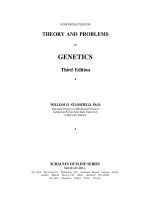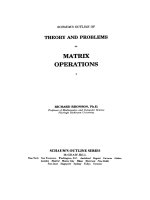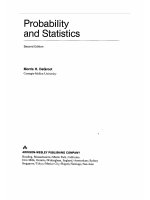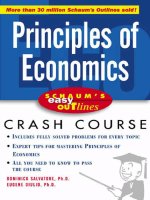Schaums easy outline of probability and statistics
Bạn đang xem bản rút gọn của tài liệu. Xem và tải ngay bản đầy đủ của tài liệu tại đây (1.65 MB, 159 trang )
SCHAUM’S Easy OUTLINES
PROBABILITY
AND STATISTICS
Other Books in Schaum’s
Easy Outline Series Include:
Schaum’s Easy Outline: College Mathematics
Schaum’s Easy Outline: College Algebra
Schaum’s Easy Outline: Calculus
Schaum’s Easy Outline: Elementary Algebra
Schaum’s Easy Outline: Mathematical Handbook of
Formulas and Tables
Schaum’s Easy Outline: Geometry
Schaum’s Easy Outline: Precalculus
Schaum’s Easy Outline: Trigonometry
Schaum’s Easy Outline: Probability and Statistics
Schaum’s Easy Outline: Statistics
Schaum’s Easy Outline: Principles of Accounting
Schaum’s Easy Outline: Biology
Schaum’s Easy Outline: College Chemistry
Schaum’s Easy Outline: Genetics
Schaum’s Easy Outline: Human Anatomy and
Physiology
Schaum’s Easy Outline: Organic Chemistry
Schaum’s Easy Outline: Physics
Schaum’s Easy Outline: Programming with C++
Schaum’s Easy Outline: Programming with Java
Schaum’s Easy Outline: French
Schaum’s Easy Outline: German
Schaum’s Easy Outline: Spanish
Schaum’s Easy Outline: Writing and Grammar
SCHAUM’S Easy OUTLINES
PROBABILITY
AND STATISTICS
B A S E D O N S C H A U M ’ S Outline of
Probability and Statistics
BY MURRAY R. SPIEGEL, JOHN SCHILLER,
AND R. ALU SRINIVASAN
ABRIDGMENT EDITOR
M I K E L E VA N
SCHAUM’S OUTLINE SERIES
M C G R AW- H I L L
New York Chicago San Francisco Lisbon London Madrid
Mexico City Milan New Delhi San Juan
Seoul Singapore Sydney Toronto
abc
McGraw-Hill
Copyright © 2001 by The McGraw-Hill Companies,Inc. All rights reserved. Manufactured in the
United States of America. Except as permitted under the United States Copyright Act of 1976, no part
of this publication may be reproduced or distributed in any form or by any means, or stored in a database or retrieval system, without the prior written permission of the publisher.
0-07-139838-4
The material in this eBook also appears in the print version of this title:0-07-138341-7
All trademarks are trademarks of their respective owners. Rather than put a trademark symbol after
every occurrence of a trademarked name, we use names in an editorial fashion only, and to the benefit
of the trademark owner, with no intention of infringement of the trademark. Where such designations
appear in this book, they have been printed with initial caps.
McGraw-Hill eBooks are available at special quantity discounts to use as premiums and sales promotions, or for use in corporate training programs. For more information, please contact George
Hoare, Special Sales, at or (212) 904-4069.
TERMS OF USE
This is a copyrighted work and The McGraw-Hill Companies, Inc. (“McGraw-Hill”) and its licensors
reserve all rights in and to the work. Use of this work is subject to these terms. Except as permitted
under the Copyright Act of 1976 and the right to store and retrieve one copy of the work, you may not
decompile, disassemble, reverse engineer, reproduce, modify, create derivative works based upon,
transmit, distribute, disseminate, sell, publish or sublicense the work or any part of it without
McGraw-Hill’s prior consent. You may use the work for your own noncommercial and personal use;
any other use of the work is strictly prohibited. Your right to use the work may be terminated if you
fail to comply with these terms.
THE WORK IS PROVIDED “AS IS”. McGRAW-HILL AND ITS LICENSORS MAKE NO GUARANTEES OR WARRANTIES AS TO THE ACCURACY, ADEQUACY OR COMPLETENESS OF
OR RESULTS TO BE OBTAINED FROM USING THE WORK, INCLUDING ANY INFORMATION THAT CAN BE ACCESSED THROUGH THE WORK VIA HYPERLINK OR OTHERWISE,
AND EXPRESSLY DISCLAIM ANY WARRANTY, EXPRESS OR IMPLIED, INCLUDING BUT
NOT LIMITED TO IMPLIED WARRANTIES OF MERCHANTABILITY OR FITNESS FOR A
PARTICULAR PURPOSE. McGraw-Hill and its licensors do not warrant or guarantee that the functions contained in the work will meet your requirements or that its operation will be uninterrupted or
error free. Neither McGraw-Hill nor its licensors shall be liable to you or anyone else for any inaccuracy, error or omission, regardless of cause, in the work or for any damages resulting therefrom.
McGraw-Hill has no responsibility for the content of any information accessed through the work.
Under no circumstances shall McGraw-Hill and/or its licensors be liable for any indirect, incidental,
special, punitive, consequential or similar damages that result from the use of or inability to use the
work, even if any of them has been advised of the possibility of such damages. This limitation of liability shall apply to any claim or cause whatsoever whether such claim or cause arises in contract, tort
or otherwise.
DOI: 10.1036/0071398384
Want to learn more?
We hope you enjoy this McGraw-Hill eBook! If you’d like more
information about this book, its author, or related books and
websites, please click here.
For more information about this book, click here.
Contents
Chapter
Chapter
Chapter
Chapter
Chapter
Chapter
Chapter
Chapter
1
2
3
4
5
6
7
8
Chapter 9
Chapter 10
Appendix A
Appendix B
Appendix C
Appendix D
Appendix E
Appendix F
Appendix G
Index
Basic Probability
Descriptive Statistics
Discrete Random Variables
Continuous Random Variables
Examples of Random Variables
Sampling Theory
Estimation Theory
Test of Hypothesis and
Significance
Curve Fitting, Regression,
and Correlation
Other Probability Distributions
Mathematical Topics
Areas under the Standard
Normal Curve from 0 to z
Student’s t distribution
Chi-Square Distribution
95th and 99th Percentile Values
for the F Distribution
Values of e−λ
Random Numbers
1
14
23
34
42
58
75
85
99
117
132
136
138
140
142
146
148
149
v
Copyright 2001 by the McGraw-Hill Companies, Inc. Click Here for Terms of Use.
This page intentionally left blank.
Chapter 1
BASIC
PROBABILITY
IN THIS CHAPTER:
✔
✔
✔
✔
✔
✔
✔
✔
✔
✔
✔
✔
✔
✔
✔
Random Experiments
Sample Spaces
Events
The Concept of Probability
The Axioms of Probability
Some Important Theorems
on Probability
Assignment of Probabilities
Conditional Probability
Theorem on Conditional Probability
Independent Events
Bayes’ Theorem or Rule
Combinatorial Analysis
Fundamental Principle of Counting
Permutations
Combinations
1
Copyright 2001 by the McGraw-Hill Companies, Inc. Click Here for Terms of Use.
2 PROBABILITY AND STATISTICS
✔
✔
Binomial Coefficients
Stirling’s Approximation to n!
Random Experiments
We are all familiar with the importance of experiments in science and engineering. Experimentation
is useful to us because we can assume that if we
perform certain experiments under very nearly
identical conditions, we will arrive at results that
are essentially the same. In these circumstances,
we are able to control the value of the variables
that affect the outcome of the experiment.
However, in some experiments, we are not able to ascertain or control the value of certain variables so that the results will vary from one
performance of the experiment to the next, even though most of the conditions are the same. These experiments are described as random. Here
is an example:
Example 1.1.
If we toss a die, the result of the experiment is that it
will come up with one of the numbers in the set {1, 2, 3, 4, 5, 6}.
Sample Spaces
A set S that consists of all possible outcomes of a random experiment is
called a sample space, and each outcome is called a sample point. Often
there will be more than one sample space that can describe outcomes of
an experiment, but there is usually only one that will provide the most
information.
Example 1.2.
If we toss a die, then one sample space is given by
{1, 2, 3, 4, 5, 6} while another is {even, odd}. It is clear, however, that
the latter would not be adequate to determine, for example, whether an
outcome is divisible by 3.
If is often useful to portray a sample space graphically. In such cases,
it is desirable to use numbers in place of letters whenever possible.
CHAPTER 1: Basic Probability
3
If a sample space has a finite number of points, it is called a finite
sample space. If it has as many points as there are natural numbers 1, 2,
3, …. , it is called a countably infinite sample space. If it has as many
points as there are in some interval on the x axis, such as 0 ≤ x ≤ 1, it is
called a noncountably infinite sample space. A sample space that is
finite or countably finite is often called a discrete sample space, while
one that is noncountably infinite is called a nondiscrete sample space.
Example 1.3.
The sample space resulting from tossing a die yields
a discrete sample space. However, picking any number, not just integers, from 1 to 10, yields a nondiscrete sample space.
Events
An event is a subset A of the sample space S, i.e., it is a set of possible
outcomes. If the outcome of an experiment is an element of A, we say
that the event A has occurred. An event consisting of a single point of S
is called a simple or elementary event.
As particular events, we have S itself, which is the sure or certain
event since an element of S must occur, and the empty set ∅, which is
called the impossible event because an element of ∅ cannot occur.
By using set operations on events in S, we can obtain other events
in S. For example, if A and B are events, then
1.
2.
3.
4.
A ∪ B is the event “either A or B or both.” A ∪ B is called the
union of A and B.
A ∩ B is the event “both A and B.” A ∩ B is called the intersection of A and B.
A′ is the event “not A.” A′ is called the complement of A.
A – B = A ∩ B′ is the event “A but not B.” In particular, A′ =
S – A.
If the sets corresponding to events A and B are disjoint, i.e., A ∩ B
= ∅, we often say that the events are mutually exclusive. This means
that they cannot both occur. We say that a collection of events A1, A2, … ,
An is mutually exclusive if every pair in the collection is mutually exclusive.
4 PROBABILITY AND STATISTICS
The Concept of Probability
In any random experiment there is always uncertainty as to whether a
particular event will or will not occur. As a measure of the chance, or
probability, with which we can expect the event to occur, it is convenient to assign a number between 0 and 1. If we are sure or certain that
an event will occur, we say that its probability is 100% or 1. If we are
sure that the event will not occur, we say that its probability is zero. If,
for example, the probability is ¹⁄ , we would say that there is a 25%
chance it will occur and a 75% chance that it will not occur.
Equivalently, we can say that the odds against occurrence are 75% to
25%, or 3 to 1.
There are two important procedures by means of which we can estimate the probability of an event.
1.
2.
CLASSICAL APPROACH:
If an event can occur in h
different ways out of a total of n possible ways, all of which
are equally likely, then the probability of the event is h/n.
FREQUENCY APPROACH:
If after n repetitions of an
experiment, where n is very large, an event is observed to
occur in h of these, then the probability of the event is h/n. This
is also called the empirical probability of the event.
Both the classical and frequency approaches have serious drawbacks,
the first because the words “equally likely” are vague and the second
because the “large number” involved is vague. Because of these difficulties,
mathematicians have been led to an axiomatic approach to probability.
The Axioms of Probability
Suppose we have a sample space S. If S is discrete, all subsets correspond to events and conversely; if S is nondiscrete, only special subsets
(called measurable) correspond to events. To each event A in the class
C of events, we associate a real number P(A). The P is called a probability function, and P(A) the probability of the event, if the following
axioms are satisfied.
CHAPTER 1: Basic Probability
5
Axiom 1.
For every event A in class C,
P(A) ≥ 0
Axiom 2.
For the sure or certain event S in the class C,
P(S) = 1
Axiom 3.
For any number of mutually exclusive events A1, A2, …,
in the class C,
P(A1 ∪ A2 ∪ … ) = P(A1) + P(A2) + …
In particular, for two mutually exclusive events A1 and A2 ,
P(A1 ∪ A2 ) = P(A1) + P(A2)
Some Important Theorems on Probability
From the above axioms we can now prove various theorems on probability that are important in further work.
Theorem 1-1: If A1 ⊂ A2 , then
P(A1) ≤ P(A2) and P(A2 − A1) = P(A1) − P(A2)
(1)
Theorem 1-2:
For every event A,
0 ≤ P(A) ≤ 1,
i.e., a probability between 0 and 1.
(2)
Theorem 1-3:
For ∅, the empty set,
P(∅) = 0
i.e., the impossible event has probability zero.
(3)
Theorem 1-4:
If A′ is the complement of A, then
P( A′ ) = 1 – P(A)
(4)
Theorem 1-5:
If A = A1 ∪ A2 ∪ … ∪ An , where A1, A2, … , An are
mutually exclusive events, then
P(A) = P(A1) + P(A2) + … + P(An)
(5)
6 PROBABILITY AND STATISTICS
Theorem 1-6:
If A and B are any two events, then
(6)
P(A ∪ B) = P(A) + P(B) – P(A ∩ B)
More generally, if A1, A2, A3 are any three events,
then
P(A1 ∪ A2 ∪ A3) = P(A1) + P(A2) + P(A3) –
P(A1 ∩ A2) – P(A2 ∩ A3) – P(A3 ∩ A1) +
P(A1 ∩ A2 ∩ A3).
Generalizations to n events can also be made.
Theorem 1-7:
For any events A and B,
(7)
P(A) = P(A ∩ B) + P(A ∩ B′ )
Assignment of Probabilities
If a sample space S consists of a finite number of outcomes a1, a2, … ,
an, then by Theorem 1-5,
P(A1) + P(A2) + … + P(An) = 1
(8)
where A1, A2, … , An are elementary events given by Ai = {ai}.
It follows that we can arbitrarily choose any nonnegative numbers
for the probabilities of these simple events as long as the previous equation is satisfied. In particular, if we assume equal probabilities for all
simple events, then
1
P( Ak ) = ,
k = 1, 2, … , n
(9)
n
And if A is any event made up of h such simple events, we
have
P( A) =
h
n
(10)
This is equivalent to the classical approach to probability. We could
of course use other procedures for assigning probabilities, such as frequency approach.
CHAPTER 1: Basic Probability
7
Assigning probabilities provides a mathematical model, the success
of which must be tested by experiment in much the same manner that
the theories in physics or others sciences must be tested by experiment.
Remember
The probability for any event must be
between 0 and 1.
Conditional Probability
Let A and B be two events such that P(A) > 0. Denote P(B | A) the probability of B given that A has occurred. Since A is known to have
occurred, it becomes the new sample space replacing the original S.
From this we are led to the definition
P ( B | A) ≡
P( A ∩ B)
P( A)
(11)
or
P( A ∩ B) ≡ P( A) P( B | A)
(12)
In words, this is saying that the probability that both A and B occur
is equal to the probability that A occurs times the probability that B
occurs given that A has occurred. We call P(B | A) the conditional probability of B given A, i.e., the probability that B will occur given that A
has occurred. It is easy to show that conditional probability satisfies the
axioms of probability previously discussed.
Theorem on Conditional Probability
Theorem 1-8:
For any three events A1, A2, A3, we have
P( A1 ∩ A2 ∩ A3 ) = P( A1 ) P( A2 | A1 ) P( A3 | A1 ∩ A2 )
(13)
8 PROBABILITY AND STATISTICS
In words, the probability that A1 and A2 and A3 all occur is equal
to the probability that A1 occurs times the probability that A2 occurs
given that A1 has occurred times the probability that A3 occurs given
that both A1 and A2 have occurred. The result is easily generalized to n
events.
Theorem 1-9:
If an event A must result in one of the mutually
exclusive events A1 , A2 , … , An , then P(A)
= P(A1)P(A | A1) + P(A2)P(A | A2) +...
+ P(An)P(A | An)
(14)
Independent Events
If P(B | A) = P(B), i.e., the probability of B occurring is not affected by
the occurrence or nonoccurrence of A, then we say that A and B are
independent events. This is equivalent to
P( A ∩ B) = P( A) P( B)
(15)
Notice also that if this equation holds, then A and B are independent.
We say that three events A1, A2, A3 are independent if they are
pairwise independent.
P(Aj ∩ Ak) = P(Aj)P(Ak) j ≠ k
where
j,k = 1,2,3
(16)
and
P( A1 ∩ A2 ∩ A3 ) = P( A1 ) P( A2 ) P( A3 )
(17)
Both of these properties must hold in order for the events to be
independent. Independence of more than three events is easily
defined.
CHAPTER 1: Basic Probability
9
Note!
In order to use this multiplication rule, all of your events
must be independent.
Bayes’ Theorem or Rule
Suppose that A1, A2, … , An are mutually exclusive events whose union
is the sample space S, i.e., one of the events must occur. Then if A is any
event, we have the important theorem:
Theorem 1-10 (Bayes’ Rule):
P( Ak | A) =
P( Ak ) P( A | Ak )
n
∑ P( A j ) P( A | A j )
(18)
j =1
This enables us to find the probabilities of the various events A1 ,
A2 , … , An that can occur. For this reason Bayes’ theorem is often
referred to as a theorem on the probability of causes.
Combinatorial Analysis
In many cases the number of sample points
in a sample space is not very large, and so
direct enumeration or counting of sample
points needed to obtain probabilities is not
difficult. However, problems arise where
direct counting becomes a practical impossibility. In such cases use is made of combinatorial analysis, which
could also be called a sophisticated way of counting.
10 PROBABILITY AND STATISTICS
Fundamental Principle of Counting
If one thing can be accomplished n1 different ways and after this a second thing can be accomplished n2 different ways, … , and finally a kth
thing can be accomplished in nk different ways, then all k things can be
accomplished in the specified order in n1n2…nk different ways.
Permutations
Suppose that we are given n distinct objects and wish to arrange r of
these objects in a line. Since there are n ways of choosing the first
object, and after this is done, n – 1 ways of choosing the second object,
… , and finally n – r + 1 ways of choosing the rth object, it follows by
the fundamental principle of counting that the number of different
arrangements, or permutations as they are often called, is given by
n Pr
= n(n − 1)...(n − r + 1)
(19)
where it is noted that the product has r factors. We call nPr the number
of permutations of n objects taken r at a time.
Example 1.4.
It is required to seat 5 men and 4 women in a row so
that the women occupy the even places. How many such arrangements
are possible?
The men may be seated in 5P5 ways, and the women 4P4 ways. Each
arrangement of the men may be associated with each arrangement of the
women. Hence,
Number of arrangements = 5P5, 4P4 = 5! 4! = (120)(24) = 2880
In the particular case when r = n, this becomes
n Pn
= n(n − 1)(n − 2)...1 = n!
(20)
CHAPTER 1: Basic Probability
11
which is called n factorial. We can write this formula in terms of factorials as
n!
(21)
n Pr =
(n − r )!
If r = n, we see that the two previous equations agree only if
we have 0! = 1, and we shall actually take this as the definition of 0!.
Suppose that a set consists of n objects of which n1 are of one
type (i.e., indistinguishable from each other), n2 are of a second type, … ,
nk are of a kth type. Here, of course, n = n1 + n2 + ... + nk . Then the
number of different permutations of the objects is
n Pn , n ,..., n
1 2
k
=
n!
n1! n2 !L nk !
(22)
Combinations
In a permutation we are interested in the order of arrangements of the
objects. For example, abc is a different permutation from bca. In many
problems, however, we are only interested in selecting or choosing
objects without regard to order. Such selections are called combinations. For example, abc and bca are the same combination.
The total number of combinations of r objects selected from n (also
called the combinations of n things taken r at a time) is denoted by nCr
or n . We have
r
n!
n
= n Cr =
r
r!(n − r )!
(23)
n n(n − 1)L(n − r + 1) n Pr
=
=
r
r!
r!
(24)
It can also be written
It is easy to show that
12 PROBABILITY AND STATISTICS
n n
=
r n − r
or
n Cr = n Cn − r
(25)
Example 1.5.
From 7 consonants and 5 vowels, how many words
can be formed consisting of 4 different consonants and 3 different vowels? The words need not have meaning.
The four different consonants can be selected in 7C4 ways, the three different vowels can be selected in 5C3 ways, and the resulting 7 different
letters can then be arranged among themselves in 7P7 = 7! ways. Then
Number of words = 7C4 · 5C3· 7! = 35·10·5040 = 1,764,000
Binomial Coefficients
The numbers from the combinations formula are often called binomial
coefficients because they arise in the binomial expansion
n
n
n
( x + y) n = x n + x n −1 y + x n − 2 y 2 + L + y n
1
2
n
(26)
Stirling’s Approximation to n!
When n is large, a direct evaluation of n! may be impractical. In such
cases, use can be made of the approximate formula
n ~ 2πn n n e − n
(27)
where e = 2.71828 … , which is the base of natural logarithms. The
symbol ~ means that the ratio of the left side to the right side approaches 1 as n → ∞.
CHAPTER 1: Basic Probability
13
Computing technology has largely eclipsed the value of Stirling’s
formula for numerical computations, but the approximation remains
valuable for theoretical estimates (see Appendix A).
Chapter 2
DESCRIPTIVE
STATISTICS
IN THIS CHAPTER:
✔
✔
✔
✔
✔
✔
✔
✔
✔
✔
Descriptive Statistics
Measures of Central Tendency
Mean
Median
Mode
Measures of Dispersion
Variance and Standard Deviation
Percentiles
Interquartile Range
Skewness
Descriptive Statistics
When giving a report on a data set, it is useful to describe the data set
with terms familiar to most people. Therefore, we shall develop widely
accepted terms that can help describe a data set. We shall discuss ways
to describe the center, spread, and shape of a given data set.
14
Copyright 2001 by the McGraw-Hill Companies, Inc. Click Here for Terms of Use.
CHAPTER 2: Descriptive Statistics
15
Measures of Central Tendency
A measure of central tendency gives a single value that acts as a representative or average of the values of all the outcomes of your experiment. The main measure of central tendency we will use is the arithmetic mean. While the mean is used the most, two other measures of
central tendency are also employed. These are the median and the mode.
Note!
There are many ways to measure the central tendency of a
data set, with the most common being the arithmetic mean,
the median, and the mode. Each has advantages and disadvantages, depending on the data and the intended purpose.
Mean
If we are given a set of n numbers, say x1, x2, … , xn, then the mean, usually denoted by x¯ or µ , is given by
x=
Example 2.1.
x1 + x 2 + L x n
n
Consider the following set of integers:
S = {1, 2, 3, 4, 5, 6, 7, 8, 9}
The mean, x¯ , of the set S is
(1)
16 PROBABILITY AND STATISTICS
x=
1+ 2 + 3 + 4 + 5 + 6 + 7 + 8 + 9
=5
9
Median
1
1
and P( X > x ) ≤ .
2
2
In other words, the median is the value where half of the values of x1,
x2, … , xn are larger than the median, and half of the values of x1, x2, … ,
xn are smaller than the median.
The median is that value x for which P( X < x ) ≤
Example 2.2.
Consider the following set of integers:
S = {1, 6, 3, 8, 2, 4, 9}
If we want to find the median, we need to find the value, x, where
half the values are above x and half the values are below x. Begin by
ordering the list:
S = {1, 2, 3, 4, 6, 8, 9}
Notice that the value 4 has three scores below it and three
scores above it. Therefore, the median, in this example, is 4.
In some instances, it is quite possible that the value of the
median will not be one of your observed values.
Example 2.3.
Consider the following set of integers:
S = {1, 2, 3, 4, 6, 8, 9, 12}
Since the set is already ordered, we can
skip that step, but if you notice, we don’t
have just one value in the middle of the list.
Instead, we have two values, namely 4 and
6. Therefore, the median can be any number
CHAPTER 2: Descriptive Statistics
17
between 4 and 6. In most cases, the average of the two numbers is
reported. So, the median for this set of integers is
4+6
=5
2
In general, if we have n ordered data points, and n is an odd
number, then the median is the data point located exactly in the middle
n +1
of the set. This can be found in location
of your set. If n is an
2
even number, then the median is the average of the two middle terms of
n
n
the ordered set. These can be found in locations
and +1.
2
2
Mode
The mode of a data set is the value that occurs most often, or in other
words, has the most probability of occurring. Sometimes we can have
two, three, or more values that have relatively large probabilities of
occurrence. In such cases, we say that the distribution is bimodal, trimodal, or multimodal, respectively.
Example 2.4.
Consider the following rolls of a ten-sided die:
R = {2, 8, 1, 9, 5, 2, 7, 2, 7, 9, 4, 7, 1, 5, 2}
The number that appears the most is the number 2. It appears four
times. Therefore, the mode for the set R is the number 2.
Note that if the number 7 had appeared one more time, it would
have been present four times as well. In this case, we would have had a
bimodal distribution, with 2 and 7 as the modes.









